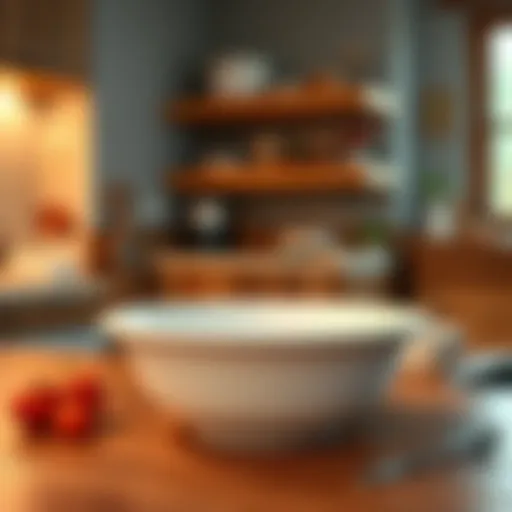The Role of Long Placemats in Home Decor and Dining
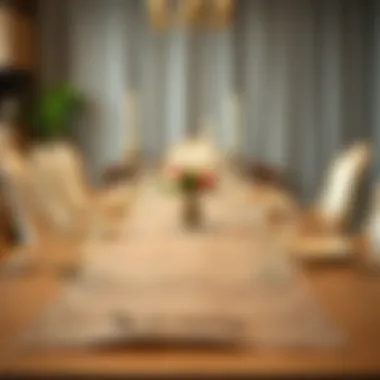

Intro
Long placemats have become an indispensable element in home decor, playing a significant role that often transcends simple functionality. Beyond their primary purpose of protecting dining surfaces, these items introduce texture, color, and personality to dining settings. From casual gatherings to formal dinners, long placemats can be a game changer in how we perceive and organize our eating areas. Their growing popularity speaks volumes about their aesthetic and practical values, catering to styles that resonate with modern sensibilities while respecting traditional charm.
In this article, we will dig deep into the role of long placemats, examining their materials, designs, and maintenance, making an argument for their importance in enhancing both the dining experience and overall home decor. With the right long placemat, a mere dinner can become a captivating experience, setting the tone and ambiance that reflect one’s personal style.
Current Fashion Trends
Long placemats are not just practical but also a centerpiece for trendy dining aesthetics. As home decor evolves, so does the role of dining accessories. Trends reflect shifts in lifestyle, with placemats stepping into the spotlight, embracing both seasonal fashion and enduring designs.
Seasonal Must-Haves
Keeping in mind the seasons, placemats can serve to highlight the vibe of any festive table. In spring, think floral prints or light pastel shades that evoke the essence of blooming flowers. Summer often calls for vivid, tropical patterns that bring a touch of the outdoors inside. As autumn approaches, rich oranges and browns can create a warm atmosphere, while winter is perfect for deeper hues or even metallic accents that shimmer under candlelight.
- Spring: Floral designs, pastel shades
- Summer: Tropical patterns, vivid colors
- Autumn: Earthy colors, rich textures
- Winter: Deep hues, metallics
Reflecting these trends speaks not only to the visual appeal but echoes a connection to the seasons and the moods they usher in.
Iconic Styles to Embrace
When considering styles, long placemats draw inspiration from various cultural aesthetics and design philosophies. For example, Japanese-inspired placemats offer minimalist lines with natural materials like bamboo, while Mediterranean styles often incorporate vibrant motifs that celebrate nature.
- Minimalist: Neutral colors, straightforward designs
- Eclectic: Bold patterns, layers of textures
- Traditional: Lace or embroidered edges for a refined look
- Modern: Geometric patterns or monochromatic themes
Each style serves as a canvas for self-expression and can easily augment a dining experience, making meals feel more like special occasions.
"The right long placemat is like a charming accessory on a well-curated outfit. It pulls everything together in a pleasing way."
Style Tips and Tricks
With power comes responsibility. Selecting the perfect long placemat requires thoughtfulness and consideration to ensure that it complements both the table setting and the dinnerware.
Mixing and Matching Outfits
When curating placemat designs, don't shy away from mixing textures and patterns. A soft textile placemat can pair beautifully with vibrant ceramic dishware, creating an unexpected yet harmonious juxtaposition.
- Tip: If unsure, start with a solid base placemat, then layer with patterned ones or add decorative items like candles or centerpieces that echo the colors of the placemat.
Care and Maintenance of Placemats
The longevity of long placemats hinges on how well they are maintained. Different materials come with their own care instructions, but general practices include:
- Washing: Opt for machine-washable options where possible, or hand wash more delicate fabrics.
- Storing: Avoid folding if possible, instead roll them up to prevent creases.
- Handling spills: Address them immediately to avoid staining, using appropriate cleaners based on the material.
By integrating long placemats into your home decor, you can create a captivating dining atmosphere that resonates with your unique taste and enhances every meal experience. Through this exploration into trends, styles, and practical care, it’s clear how significant a well-chosen long placemat can be in defining the essence of any dining area.
Understanding Long Placemats
Long placemats serve more than just their primary function of protecting the dining surface from spills and stains; they are pivotal in elevating a dining area’s overall aesthetic and atmosphere. As casual as they seem, these textile adornments can reflect a host of sentiments, tying together the ambiance of the meal or occasion. The attention to detail in selecting placemats can be the difference between a drab setting and an elegantly curated table that speaks to the host's style and intention.
Definition and Dimensions
Long placemats are typically characterized by their extended length, differing from standard size versions that may only cover a portion of the table. These pieces often stretch across the entire table length, providing a continuous canvas that adds a cohesive touch. Their dimensions can vary depending on the intended use, with sizes ranging from 18 inches to 36 inches in width and substantial lengths that complement both larger dining setups and smaller arrangements.
Using long placemats can visually elongate the dining space, creating an inviting and well-structured environment. Furthermore, when choosing dimensions, one must consider both the table size and the proportions of existing decor. For instance, a robust, rustic table may pair beautifully with oversized placemats, while a sleek, modern table might benefit from more streamlined versions. It's essential to strike a balance that maintains the visual flow while incorporating functional aspects of dining.
Historical Context
The roots of placemats can be traced back centuries, where they originally functioned as protective layers for dining surfaces in homes of various affluence. In many cultures, dining is a ceremonial affair, and placemats played an essential role in setting the stage for these rituals. In ancient Greece, tabulae were used not just to shield the table but as platforms for displaying abundant feasts, showcasing that even in antiquity, the presentation mattered.
As time went on, the design of placemats evolved, parallel to changing dining customs and materials. The transition from mere plain fabric to decorative elements occurred during the Victorian era, where personalization became more common. The advent of synthetic fabrics and diverse materials in the 20th century brought about a resurgence in styles, allowing for greater creativity.
In recent decades, long placemats have gained significant traction as essential accessories in modern home decor. They now serve not only a functional role but become part of the design dialogue in defining personal style. In contemporary settings, these placemats often showcase intricate designs or bold colors that reflect current trends, illustrating that their importance is not just rooted in utility but also in artistic expression.
"Long placemats are not merely decorative additions but are intrinsic to the narrative of any dining experience, combining history, function, and style into one feature of decor."
In essence, understanding long placemats encompasses appreciating their multifaceted role across history, recognizing their evolution, and celebrating their impact on the dining experience today.
Materials Used in Long Placemats
When it comes to long placemats, the materials used play a pivotal role in their aesthetic appeal, functionality, and longevity. It's not just about picking any fabric or texture that looks good; the right choice can enhance the dining experience, reflect personal style, and offer practical benefits. From durability to maintenance ease, understanding the array of materials available is essential for anyone looking to elevate their home decor through long placemats.
Fabric Options
Cotton
Cotton is extraordinarily versatile. It’s soft to the touch and available in a myriad of designs, making it a favorite among homeowners. The breathable nature of cotton ensures that it doesn’t easily trap heat, which is especially important when serving hot dishes. A standout characteristic of cotton is its ability to withstand machine washing, standing up well to frequent cleaning. While cotton is generally durable, it can lose its brightness over time, necessitating some care in color choice.
Linen
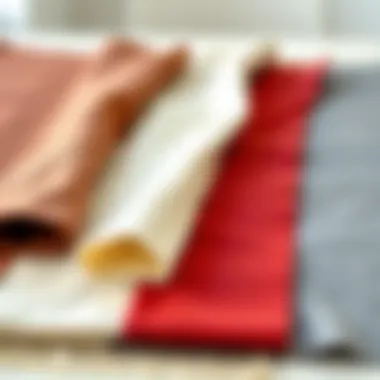
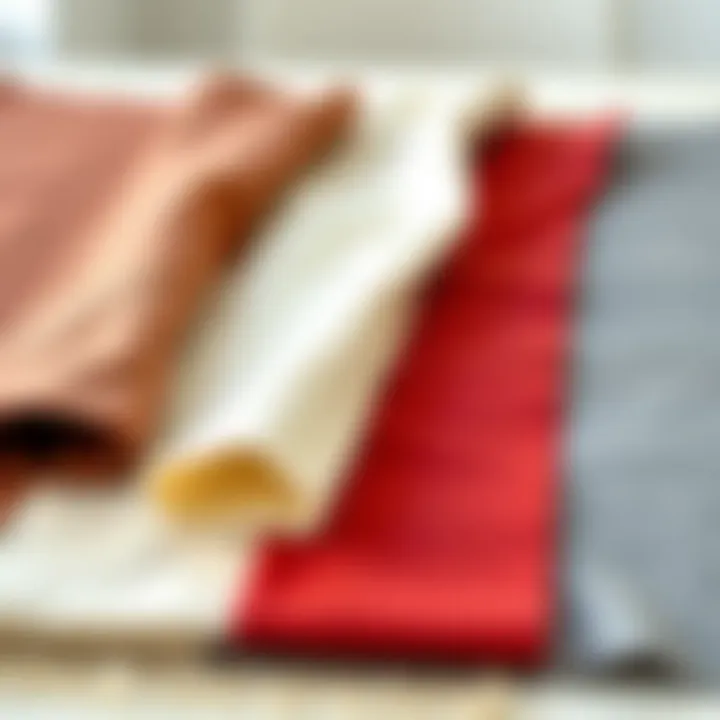
Linen's history speaks volumes about its quality. Often associated with luxury, this fabric is made from flax fibers and is known for its textured feel and natural luster. Linen's breathability makes it a suitable option for warmer climates, as it allows air to flow. However, it can be prone to wrinkling, which might be a drawback for some. Still, the rich and cultured appearance that linen brings to a dining table can hardly be overstated. For a touch of elegance, linen is hard to beat.
Synthetic Fabrics
Opting for synthetic fabrics like polyester can be a game changer. Their resilience against stains and spills makes them a smart choice for everyday use. Synthetic materials often mimic the look and feel of natural fibers while providing increased durability. The biggest perk? They come in a vast array of colors and patterns. However, some may argue that synthetic fabrics don’t have the same warmth or organic feel as cotton or linen. Still, for busy households, they can strike a fine balance between style and practicality.
Natural Materials
Bamboo
Bamboo placemats bring a unique appeal, combining natural beauty with sustainability. As a fast-growing plant, it's an environmentally friendly option. The smooth surface of bamboo placemats can add an exotic touch to the dining area. They are not only attractive but also incredibly durable. However, they may require special care to maintain their finish, and their inflexibility compared to fabric may limit placements on certain tabletop configurations.
Jute
Jute placemats are all about earthy vibes. This natural fiber has a rustic charm that fits well with bohemian or farmhouse aesthetics. Considered eco-friendly, jute is strong and relatively inexpensive, making it a practical choice. Yet, they can be less suited for formal settings. Their rough texture may absorb spills if not treated properly, which could lead to cleaning headaches.
Leather
For those wanting to infuse a hint of luxury, leather is an excellent material for long placemats. It exudes sophistication and can complement both modern and traditional dining decor. Unlike fabric, leather allows for myriad customizations, from embossing to various dye colors. Despite its appeal, one downside is that leather requires regular conditioning to avoid drying out and cracking, which may deter less diligent maintainers.
Innovative Materials
Recycled Materials
In an age increasingly focused on sustainability, recycled materials are shining stars. Utilizing fabrics made from recycled plastics, for instance, shows a commitment to the environment while still achieving stylish outcomes. They can be durable and resistant to spills, often providing a carefree dining experience. However, some consumers might prefer natural fibers for their unique look and feel, making this a choice that straddles practicality and aesthetics.
Waterproof Fabrics
The rise of waterproof fabrics cannot be ignored. Ideal for families with children or those who enjoy frequent dinners al fresco, these materials repel spills and stains like nobody’s business. They maintain their vibrant colors and patterns even after repeated use. Though they serve practicality well, some may feel that waterproof options lack the soft touch or high-end look of traditional fabrics. However, they can effectively blend utility with decorative charm.
"Choosing the right material for long placemats is like selecting the perfect frame for a masterpiece; it enhances the beauty and utility of the dining experience."
Understanding these materials offers a strategic advantage in selecting long placemats that not only fit the decor but also meet functional expectations.
Design Styles of Long Placemats
Long placemats are a subtle yet powerful element in interior design. They not only protect your dining surface but also enhance aesthetic appeal. The design style of long placemats can set the scene for countless dining experiences, transforming ordinary meals into extraordinary occasions. The importance of selecting the right design style lies in its ability to either blend seamlessly with existing decor or create a striking focal point. This section delves into three distinct design styles: minimalist aesthetics, bohemian elements, and classic and traditional styles.
Minimalist Aesthetics
Minimalism talks in whispers rather than shouts. For instance, a long placemat in a soft earth tone can quietly ground a space without overwhelming it. When we think of minimalist aesthetics, the focus is on simplicity and functionality. Long placemats used in this style are often made from materials like linen or cotton in neutral colors. They serve not just as decoration but also enhance the overall functionality of the dining area.
Using minimalist placemats can help create a calm atmosphere, essential for both casual dinners and formal gatherings. This aesthetic encourages an uncluttered look that emphasizes clean lines and subtle textures. Consider opting for a placemat that has a slight texture—an imperceptible woven pattern can elevate the overall design without taking center stage.
Bohemian Elements
In stark contrast, a bohemian style exudes vibrancy and warmth, celebrating individuality and creativity. Long placemats that align with this aesthetic often feature bold colors, eclectic patterns, and various textures. These placemats might be made from materials such as jute, which adds an organic touch, or embellished with colorful embroidery or fringe detailing.
The bohemian style allows for personal expression—think mismatched dinnerware paired with patterned long placemats. It invites a laid-back and inviting dining vibe, ideal for casual get-togethers. When incorporating bohemian elements, don't shy away from layering placemats for extra depth and dimension; combining textures can create an enchanting tablescape that feels lived-in yet stylish.
Classic and Traditional
Classic and traditional styles evoke a sense of nostalgia and timeless elegance. Long placemats in this category typically showcase rich fabrics, such as damask or satin, often featuring intricate patterns or monograms. The color palettes lean towards burgundy, deep green, or navy, resonating with opulence.
These placemats play a pivotal role in formal dining settings, serving as a canvas for fine china and stemware. For a quintessential traditional dining experience, pair a bold placemat with equally sophisticated dinnerware. A classic long placemat sets a dignified tone, ideal for festive gatherings or holiday meals, showcasing a refined taste that never goes out of style.
"The right placemat can enhance the dining experience, bridging together aesthetics and functionality."
In sum, the design style of long placemats can profoundly influence the overall dining experience. Whether you lean towards simplicity, embrace the eclectic flair of bohemian design, or honor the legacy of classic styles, selecting the right long placemat becomes pivotal in creating the ambiance that corresponds with your dining objectives. This mindful approach to home decor elevates not only the look of your table but also nurtures the spirit of each meal shared.
Practical Uses of Long Placemats
Long placemats hold a significant place in home décor, serving not just as protective barriers for tables but enhancing the overall dining experience. Their versatility spans from formal settings to everyday meals, making them an indispensable accessory in every household. Associating practicality with aesthetic appeal is where long placemats truly shine.
Formal Dining Settings
When hosting a formal dinner, long placemats bring a touch of elegance and sophistication to the table. They act as a canvas on which the entire setting is painted. Imagine crisp, white linen placemats executing their role splendidly against fine china and gleaming silverware. The use of long placemats can help delineate each guest's spot while also catching any spills or crumbs from the table, keeping the environment tidy and refined.
Moreover, these placemats provide an opportunity to play with colors. A stark contrast, like a deep navy placemat under pale dishes, can make the presentation pop. The visual impact is undeniable, providing a feast for the eyes that complements the culinary artistry.
"An elegantly set dining table speaks volumes before a word is spoken."
Casual Gatherings
In contrast, casual gatherings often need less formality but can still benefit from the inclusion of long placemats. They're perfect for family meals, game nights, or even brunch with friends. Here, you can opt for playful patterns or brighter colors that reflect a more relaxed atmosphere. Unique designs or even themed placemats can serve as conversation starters, adding to the merriment of the occasion.
In casual settings, long placemats also serve a useful purpose in maintaining cleanliness. A hurried server might spill a bit of sauce while bringing out a dish, and having a protective layer can be a godsend against stains. Beyond cleanliness, the right placemat can add charm and heart to an informal gathering, turning a simple meal into an experience worth remembering.
Everyday Use
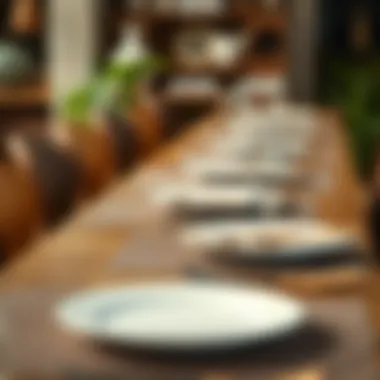

In daily life, long placemats offer substantial practicality. Whether it's breakfast with a cup of coffee or dinner after a long day, these placemats help create a welcoming space for meals. They are instrumental in protecting the dining surface from scratches, heat marks, and spills that can occur during day-to-day dining.
Furthermore, long placemats can also contribute to the overall design of a kitchen or dining area. Matching or coordinating them with other elements like curtains or table runners introduces cohesion to the space. An appealing table setting every day might also encourage family members to gather more often, fostering connection and conversation.
Overall, the practical uses of long placemats extend beyond mere functionality. They enhance the dining experience, whether it’s the high stakes of a formal dinner or the comforting familiarity of a family meal. Their role is not just to protect, but also to elevate, unify, and beautify. This versatility shows just how crucial these simple pieces can be in day-to-day life.
For more insights, you may want to explore resources at Britannica or check discussions on Reddit.
Long Placemats and Ambiance
Long placemats serve more than just a functional purpose at the dining table; they significantly influence the ambiance of a space. Their presence can transform a simple meal into an elegant dining experience, making them crucial in home decor. These decorative elements not only provide a barrier against spills and scratches but also lend a touch of sophistication to table settings. With careful selection, long placemats can enhance the color palette of a room, contributing to a cohesive overall aesthetic.
When considering how long placemats impact ambiance, one must also think about the materials and designs. For instance, a vibrant cotton placemat can inject a playful element into an otherwise formal setting, while a luxurious linen option effortlessly elevates the space, echoing the elegance of fine dining.
"The choice of your placemats can narrate a story, shape the mood, and even set expectations for your guests."
This potential for storytelling through design accentuates their importance. Let's delve deeper into how specific elements, such as color and texture, can sway the overall atmosphere of a dining experience.
How Color Influences Mood
Color plays a pivotal role in establishing the feel of a space. Different shades evoke distinct emotions and responses, making the choice of long placemats essential in crafting the desired ambiance. For example, warm colors like reds, oranges, and yellows are often associated with comfort and intimacy; they invite conversation and foster a cozy environment. Conversely, cooler tones such as blues and greens can promote calmness and relaxation, making them ideal for serene dining environments.
Additionally, a pop of color can also become a conversation starter, as vibrant hues naturally draw attention. Imagine a neutral dining room suddenly illuminated by a bold fuchsia placemat—it’s instantly eye-catching. It's not just about food presentation; it's about creating an enjoyable experience.
- Warm Colors: Inviting, cozy, and stimulating hunger.
- Cool Colors: Calm, relaxing, and promoting conversation.
- Neutral Tones: Serve as a balanced backdrop, highlighting other decor elements without overpowering them.
Textural Variations
Textures add depth and interest to the visual presentation of a dining setting. Long placemats come in various materials, each contributing its own tactile experience and aesthetic value. A woven jute placemat brings an earthy, rustic charm, complementing a farmhouse-style table, while a glossy synthetic fabric can lend a modern flair to a contemporary dining experience.
The interplay of textures can elevate even the most mundane dining arrangements:
- Rough Textures: Typically create a relaxed, informal atmosphere—perfect for casual meals with family.
- Smooth Textures: Evoke sophistication, ideal for formal gatherings and elegant affairs.
Long placemats, when chosen wisely, can offer varying textures that appeal to the senses, engaging guests in a more profound way. When someone runs their fingers over the uneven weave of a bamboo placemat or the silky finish of a satin option, it adds a layer of sensory richness to the meal. By combining colors and textures effectively, one can curate a dining scene that not only looks appealing but also feels inviting.
Care and Maintenance of Long Placemats
Taking care of long placemats is like maintaining a fine piece of art in your home. It’s not just about keeping them clean; it’s also about preserving their charm and longevity. Proper care ensures your placemats remain not only visually appealing but also functional in creating an inviting dining atmosphere.
Cleaning Techniques for Different Materials
Every material has its own quirks, and knowing how to properly clean your long placemats can make all the difference. Whether you’re using placemats made from cotton, jute, or synthetic fabrics, here are some effective techniques:
- Cotton Placemat: Regularly wash cotton placemats in warm water with a mild detergent. Avoid bleach, as it tends to weaken the fibers. For stubborn stains, a gentle scrub with a soft brush may help.
- Linen Placemat: Linen is delicate but can tolerate a bit more heat. Hand washing is preferable, as machine washing can create wrinkles and diminish the fabric's natural sheen. Air-dry them to avoid heat damage.
- Synthetic Fabrics: These are typically the easiest to maintain. Most are machine washable and can often tolerate higher temperatures. However, check the care label first, as some may require a gentle cycle to avoid pilling.
- Natural Materials: For bamboo or jute placemats, a damp cloth can be sufficient to wipe down the surface. Avoid soaking them in water, as prolonged exposure can warp the material.
"A little care goes a long way; it’s far easier to maintain than to restore!"
Storage Recommendations
Storing placemats correctly can enhance their lifespan. Here are some simple yet effective tips to consider:
- Flat Storage: For fabric placemats, stacking them flat is ideal to prevent creases and warping. Use a drawer or a shelf dedicated to linens, keeping them away from heavy items that might squash them.
- Roll for Natural Materials: If you’re dealing with bamboo or jute, rolling them instead of folding them helps maintain their shape. You can store them in a braid or a storage bin to keep them organized.
- Avoid Heat and Humidity: Long placemats should be kept in a cool, dry place, away from direct sunlight. Heat can damage natural fibers and cause synthetic materials to degrade over time.
Following these care and maintenance tips will keep your long placemats looking fresh and ready to impress for every dining occasion. Investing in their maintenance is an investment in your home’s overall aesthetic appeal.
Personalization and Customization
Personalization and customization are integral to home decor, especially when it comes to long placemats. These elements not only reflect individual style but also serve to create a unique atmosphere that speaks to both aesthetics and function. With today’s focus on tailored living spaces, the choice of placemats can transform ordinary dining experiences into delightful occasions.
One of the key aspects of personalizing long placemats is the possibility for unique designs that resonate with the owner's character. This goes beyond mere aesthetics; it tells a story about the home and its inhabitants. Personalized items like monograms or custom embroidery add a layer of intimacy and thoughtfulness that mass-produced items simply can’t replicate. This attention to detail leaves a significant impact, making the decor feel intentional rather than an afterthought.
The benefits of customized placemats extend into the realm of practicality. Customized pieces can often accommodate specific needs related to size and functionality. For instance, a larger mat can be designed to perfectly fit a family dining table, while smaller, specialized sets can serve individual settings for more casual dining. This adaptability makes customization not just a creative choice but a practical one as well.
Monograms and Embroidery
Monograms and embroidery on long placemats create a striking visual element that enhances the dining experience. These delicate designs are not just decorative; they are emblematic of how personal touches can elevate home decor. Many people opt for initial monograms, which not only identify the household but also give a distinguished look to the table setting.
Additionally, embroidery can celebrate significant milestones or events, like anniversaries or family gatherings. This means using placemats to mark special occasions isn’t just about celebration; it’s about creating lasting memories each time you set the table. Each meal becomes a part of the narrative.
When considering the size and style of the embroidery, it’s important to balance elegance with practicality. Large, bold fonts can attract attention but may dominate smaller dining spaces. Conversely, small, intricate designs may suit a more minimalist setting. Thus, choosing the right style can help achieve desired ambience.
Color Coordination with Table Settings
The interplay of colors in long placemats and table settings can define the mood of a gathering. Color coordination transforms a simple meal into a meticulously designed event. For instance, coordinating a placemat’s color with dinnerware or napkin shades can create a harmonious look that draws the eye and elevates the dining experience.
A few principles to consider when mixing colors include:
- Complementary colors: Choosing colors that are opposite each other on the color wheel creates visual contrast, making every element of the setting pop.
- Analogous colors: Picking colors that are next to each other on the wheel provides a softer, more blended look that can feel calm and inviting.
- Monochromatic schemes: Sticking to various shades of the same color can portray sophistication and style, ideal for formal settings.
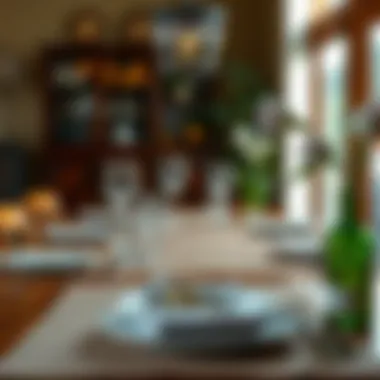
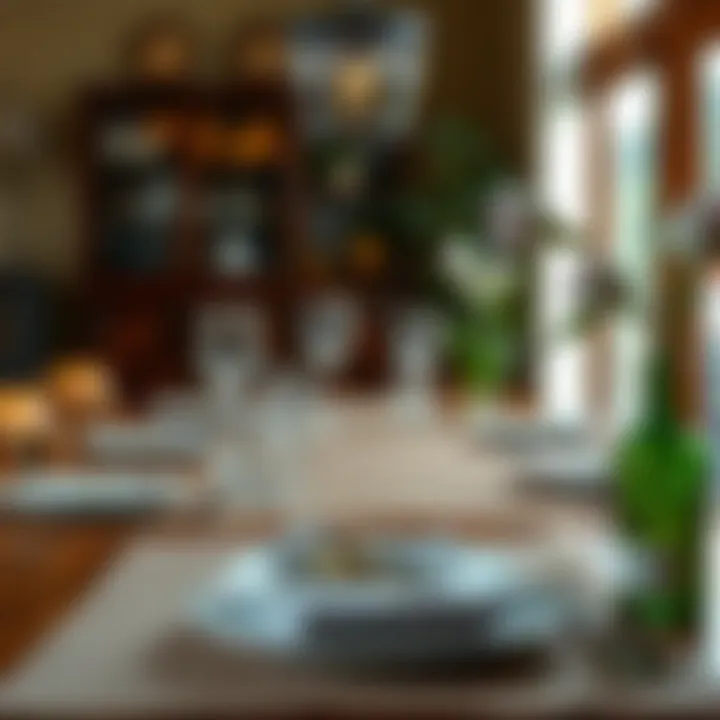
To create that perfect match, it often helps to have fabric swatches or color samples on hand. Taking a little time to experiment can reveal surprisingly delightful combinations that might otherwise go unnoticed. Ultimately, carefully chosen colors in placemats can influence diners' emotions and experiences, from the vibrancy of a summer gathering to the warmth of a cozy winter meal.
The Role of Long Placemats in Cultural Settings
Long placemats serve more than just a functional purpose on a dining table; they carry significant cultural weight and reflect the values and traditions of various societies. When exploring the intricacies of home decor, it becomes glaringly obvious that these seemingly simple items embody a greater narrative—one of heritage, hospitality, and identity. As we delve into this section, let’s explore how long placemats play a pivotal role in aligning dining experiences with cultural significance.
Dining Traditions Across Cultures
Dining traditions greatly vary across cultures, and long placemats often find themselves at the heart of these practices. In many Eastern cultures, for instance, meal sharing holds immense importance. A long placemat, elegantly laid across a long table, allows families to gather around, fostering a sense of community and togetherness. The round or rectangular shape often encourages conversations and connections. This is particularly prevalent in cultures where meals are not just about food but about building relationships.
In Italy, for example, long tables adorned with beautiful platters and matching placemats during family gatherings create an inviting atmosphere, encouraging everyone to exchange stories and enjoy each other's company. The design often reflects regional aesthetics, combining colors and patterns native to the location, making the entire setup a visual feast.
The communal aspect of dining in cultures like Indian or Middle-Eastern also emphasizes this point. Here, long placemats can accommodate sharing plates or thalis filled with a variety of dishes, encapsulating the spirit of generosity and hospitality. The presence of a long placemat in such settings signifies an openness to share, enhance the dining experience, and respect cultural values tied to mealtime interaction.
Symbolism in Various Cultures
Moving beyond functionality, the symbolism associated with long placemats differs from one culture to another. In some traditions, the choice of color, material, and even patterns can convey messages of prosperity and abundance. For example, in Chinese culture, colors such as red are thought to bring luck and are therefore widely used in dining settings. A long red placemat, spread across a table during festive occasions like the Lunar New Year, serves as more than just a decorative piece; it reflects hope for good fortune in the upcoming year.
Moreover, the craftsmanship involved in creating long placemats often ties back to cultural heritage. Handwoven fabrics or those featuring traditional motifs carry stories and values that resonate within communities. This demonstrates a connection to ancestry, honoring skills honed over generations.
Environmental Considerations
In today's world, being environmentally conscious is more important than ever, and this notion extends to home decor, including the use of long placemats. As desig n enthusiasts and mindful consumers, stylists and retailers alike are increasingly looking for ways to incorporate sustainability into their products. Long placemats play a pivotal role in this shift, offering not only style but also an opportunity to make eco-friendly choices in home decor.
Sustainable Materials
When it comes to long placemats, the materials used can significantly impact the environment. Consumers are seeking placemats made from sustainable materials, which are a boon for our planet. Options like organic cotton, which is grown without the use of synthetic pesticides, are gaining traction. Another compelling choice includes bamboo, known for its rapid growth and minimal resource requirements, making it an excellent eco-friendly material.
- Bamboo: Fast-growing and requires little water, making it a sustainable option.
- Organic Cotton: Pesticide-free and biodegradable, contributing to a cleaner earth.
- Recycled Fabrics: Utilizing post-consumer waste helps mitigate landfill issues and reduce production waste.
Choosing these materials not only enhances the aesthetic qualities of a dining space but also aligns with global efforts to promote sustainable living. Furthermore, they often provide unique textures and colors, adding depth to any decor scheme, something plain synthetic materials struggle to achieve.
Impact of Production Practices
The journey of a long placemat doesn’t just end with the choice of materials; production practices also bear a great responsibility. It's crucial to select long placemats that have been manufactured under fair labor practices while minimizing waste and energy consumption. There’s a growing trend toward manufacturers who prioritize ethical production techniques, which ensures that the environment and human rights are both taken seriously.
For instance, brands that utilize solar energy in their manufacturing processes or implement strict waste reduction tactics promote a cleaner production cycle. This speaks volumes about their commitment to environmental responsibility and can resonate heavily with consumers looking for conscious purchasing choices.
"Opting for products from brands that are transparent about their production methods not only showcases personal values but also influences wider change within the industry."
Moreover, supporting local artisans and small businesses can minimize transportation emissions, further benefiting the environment. It’s about making informed decisions that consider both style and sustainability, and long placemats provide the perfect vehicle for that consciousness.
Incorporating long placemats made from sustainable materials and from ethical production practices not only elevates the dining experience but also contributes positively to the environment. As consumers become more educated and discerning, the importance of these factors in home decor cannot be overstated.
Trends in Long Placemats
The space within a home can be thought of as a canvas, with decor choices acting as brushstrokes that create a cohesive masterpiece. Long placemats, once considered mere functional items, have transformed into significant elements in modern decor. As designers and homeowners alike navigate the evolving landscape of style preferences, understanding current trends in long placemats is crucial for anyone looking to elevate the dining experience in their home.
Current Market Trends
Recent trends indicate that consumers are leaning towards sustainability as a core consideration when selecting home decor. The demand for long placemats produced from eco-friendly materials has surged. Choices like organic cotton or recycled synthetic fabrics are favored because they not only enhance aesthetic appeal but also have less impact on the environment. This inclination towards natural and sustainable materials resonates deeply with a growing segment of consumers who value responsible consumption.
Another noticeable trend is the color palette variation. While past seasons were dominated by muted tones, the tide has shifted towards bold and vibrant hues. Deep greens, striking terracotta, and rich indigos can make a powerful statement. These colors not only catch the eye but also create a sense of warm hospitality at the dining table. Variegated patterns, such as stripes or geometric designs, shift the focus away from traditional settings, allowing for personal expression.
Additionally, the commitment to textural diversity is commendable. Long placemats are being produced with untreated fabrics that present a raw, organic look, appealing to those who appreciate a natural aesthetic. The discovery of materials like jute and bamboo has also changed the game, blending rustic charm with modern chic.
To summarize, some of the key market trends include:
- Eco-Friendly Materials: Organic cotton, bamboo, and recycled synthetics.
- Bold Color Palettes: Vibrant tones like teal, orange, and deep red.
- Textural Exploration: Emphasis on raw, untreated fabrics.
"Placemats now surpass mere functionality— they’re craft elements that bridge styles and sustainability."
Forecasting Future Styles
Peering into the future, one cannot help but notice the likelihood of technological influences weaving their way into the design of long placemats. With advancements in smart textiles, we might see the emergence of placemats that offer features like stain resistance or heat resistance that adapt to various dining needs. Imagine a placemat that changes color based on temperature— offering functionality wrapped in sophistication.
A notable shift is anticipated towards minimalism. As living spaces shrink and priorities shift, a cleaner aesthetic will dominate. The long placemat could take on a more streamlined approach—think simple patterns, fewer embellishments, and a strong focus on quality over quantity. The objective will be clarity and enhance the dining experience without overwhelming the surroundings.
Surprisingly, the trend of mixing styles is likely to persist. Future designs may no longer confine themselves to a single aesthetic; instead, we'll witness an evolution where luxurious velvets pair with rustic timbers or sleek metals blend with organic shapes. This eclectic approach encourages individual tastes to personalize dining experiences.
Lastly, consumers will probably continue to increasingly emphasize the cultural significance of placemats. As global influences mingle more in the dining realm, long placemats may adopt motifs and patterns that tell stories of different cultures. This synchronicity adds depth to the simple act of dining, enriching both atmosphere and conversation.
In closing, the future is bright for long placemats. As trends evolve, they will undoubtedly reflect the needs and preferences of a discerning audience.
Closure
In wrapping up this exploration of long placemats, it becomes clear how integral they are to both aesthetic appeal and pragmatic functionality in home decor. Their presence on a table does more than protect surfaces; it elevates the dining experience, transforming mundane meals into remarkable occasions.
Final Thoughts on Long Placemats
Long placemats offer a blank canvas for creativity in your dining space. Whether fashioned from natural materials like bamboo that echo sustainability or synthetic options that promise resilience, these pieces cater to various tastes and lifestyles. When one considers how different colors and textures can influence personal ambiance and set the mood for gatherings, the importance of selecting the right placemat is undeniable.
"A well-placed mat can make or break the entire dining atmosphere, bringing not just style but also cohesion to your decor."
Choosing a long placemat isn't merely about aesthetics; it's about reflecting your unique style and enhancing the overall dining experience. From casual brunches to formal dinners, they provide versatility and function. Thus, the thoughtful integration of long placemats into home decor echoes a commitment to quality and an eye for design.
As you navigate your options, remember that the right long placemat doesn't just complement your table — it tells a story, invites conversation, and fosters community. Embracing this simple detail can have far-reaching effects on how one experiences their home, making it a vital topic in modern home decor discussions. With the information articulated here, stylists, designers, and retailers are well-equipped to appreciate and advocate for the profound impact long placemats can have on the dining ambiance.

